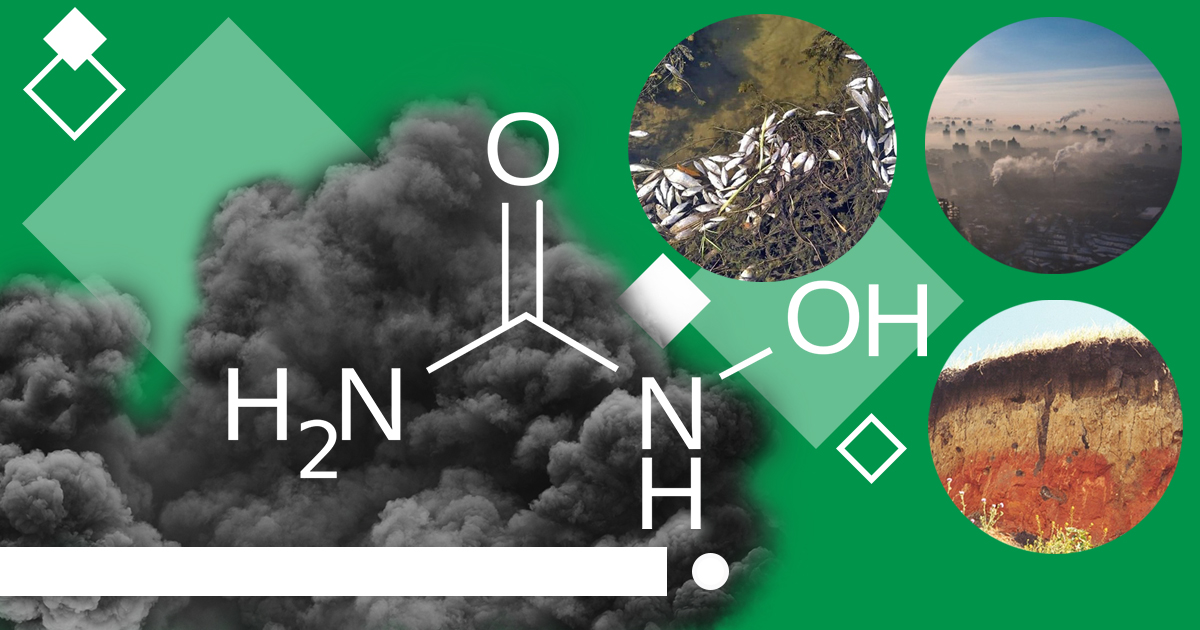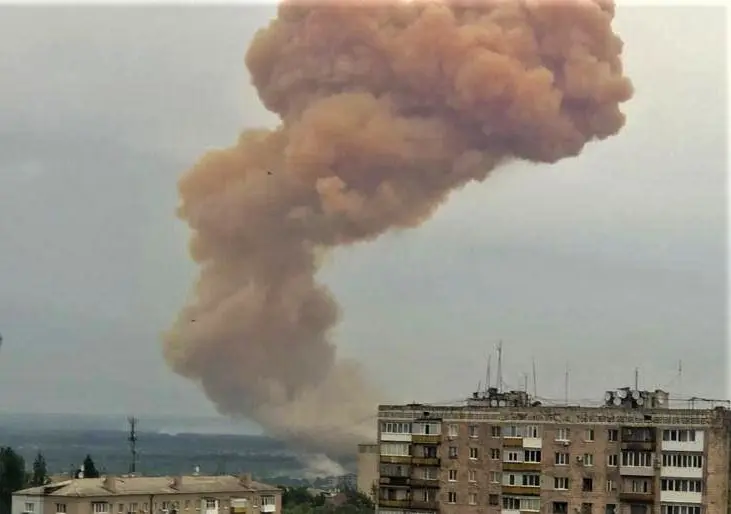We are telling how pollution can spread after the enemy's attacks on chemical and other enterprises, as well as how to counter their consequences in the long run.




On May 31, the occupiers launched an air strike on the Azot chemical plant in Sievierodonetsk, Ukraine's third-largest ammonia producer and one of Europe's largest chemical companies. The russians destroyed the nitric acid tank, causing a leak of nitrogen; an orange cloud rose into the sky. We remind you that nitrogen is a dangerous chemical compound that irritates the respiratory tract if inhaled, swallowed, and gets on the skin and mucous membranes, and can even lead to death. It is what threatens the residents of Sievierodonetsk and threatened those who were in Rubizhne when the russians aimed at a tank of nitric acid in early April. But the nitrogen leak in Sievierodonetsk and Rubizhne is not all the damage to the environment and health of Ukrainians that the russians are deliberately inflicting on us.
The shelling of chemical facilities is extremely dangerous. It affects the environment and directly threatens human life and health. As we have already reported about safety rules during accidents at chemical plants, this time, Rubryka decided to raise the issue of the long-term impact of such accidents on the environment. We will figure out whether it is possible to protect oneself and repair the damage already done before it is too late.
Consequences of Russia's missile strike on the Darnytsia Car Repair Plant in Kyiv
We are dealing with chemical contamination of the damaged area after any missile attacks. It was stated by the ecologist and project coordinator of the NGO "Ecoltava" Nadiya Groza. This process begins with the rocket detonation releasing carbon monoxide, carbon dioxide, nitrogen oxides, sulfur dioxide, metal oxides (aluminum, iron, etc.), and gaseous and solid products of incomplete oxidation of explosives. Then these substances are absorbed into the soil and, consequently, into the surface waters. At the same time, not only the local area of impact (for example, the plant area) is polluted, but everything nearby: harmful compounds are dispersed by wind and fall in the form of rain.
Attacks are catastrophic when they hit chemical objects and cause explosions and fires. The head of the All-Ukrainian Environmental League, Tetyana Tymochko, claims that the explosions and burning of thousands of tonnes of oil products have led to sulfur and lead release. When sulfur dioxide and nitrogen compounds combine with water and oxygen, sulfuric and nitric acids form, and we are already dealing with acid rain. Not to mention the damage from direct contact with living organisms, acid rain also corrodes metals, paints, and synthetic compounds and destroys architectural monuments.
But the danger is not limited to strikes on oil depots or plants that produce nitrogen fertilizers or store large amounts of chlorine:
"All types of enterprises use something," says environmental safety expert Maksym Soroka. "Even our food industry is very "chemical." That is why every enterprise has an increased level of environmental danger," he explains.
An attempt to use such a "chemical" method, when the leakage of specific substances is more striking than the shelling itself, happened in late April when the russians launched two missiles in the direction of the Odesa port refrigeration plant. Our air defenses shot down both of them. It was also considered a chemical attack, as hitting the facility could have caused chemical contamination.
Not all leaks cause long-term damage to the environment. But harmful substances can spread through the territory unpredictably.
For example, in early April in the Rivne region near the villages of Sapanivchyk and Bereg in the Dubno district, locals noticed that dead fish had appeared in the Ikva river, and the water had acquired an unusual color. Before that, the missile fragments damaged six tanks with mineral fertilizers in the Kremenets district. It was not surprising that after the State Consumer Service analysis, the ammonium content in the water was several times higher than normal. People were immediately advised not to collect water for consumption either in the Ikva River or in the wells of the villages downstream. But within a few days, the situation improved:
"We understand well how ammonia works. It is unstable, it evaporates, it naturally disappears, and we will forget about it in our territory in two days," said Olexander Fedorov, the Head of Smyzka territorial community, which borders the Kremenets district.
Indeed, in the area of the mentioned villages the day after the accident, the water analysis showed that all indicators were normal. However, this does not mean that the damage has completely dropped. The threat has disappeared only in the area in question. The head of the regional center for disease control and prevention Roman Safonov noted that the movement of pollution is a "natural" phenomenon. The ecologist does not rule out that there may be a hydrogeological window somewhere, and the river may enter the surface layer of water, which is used by humans. It may happen even twenty or thirty kilometers from where the analysis was taken. That is why environmentalists conduct monitoring throughout the region, not just in the area where a particular enterprise was damaged.
The Government's Resolution № 303 suspended almost all scheduled and unscheduled inspections during martial law, except the inspections in several areas, including human life, health, and environmental protection. They can be carried out for various reasons, but the main thing is that even during martial law, we still have the right to apply to the State Environmental inspection for an ecology quality inspection. It applies to the quality of water, soil, air, etc.
You can urgently report violations, as well as find out at what stage of considering your application is, by calling the hotline +38 (044) 521-20-38 or online – through SaveEcoBot.
In addition, the state inspects business entities in the event of an accident, including after damage due to hostilities.
Heavy substances that remain in the ground after hostilities and contaminate soils can enter food chains and accumulate in the body. However, it is impossible to say unequivocally how long they will remain in the ground and water and how much they can harm us. Environmental safety expert Maxym Soroka notes that everything depends on the concentration of the substance, and without prior analysis, no conclusions can be drawn:
"Just so you know, one tank of a substance is 30 tons of nitric acid, and often more than half of that acid is converted to nitrogen dioxide because of a disproportionation reaction. It finds any reducing agents and starts breaking itself down. And it is very difficult to say about the damage because it is unclear in which direction the wind sent the evaporation. Now I try not to comment on anything. You can say something only from some testimonies and photographs, based on your experience, but in any case, you need to do an analysis. If we talk about Azot, I still do not understand what exploded there, judging by the video. "
"The chemical distribution in the area depends on its amount in the environment, the terrain, the wind, the weather conditions," adds Anna Ambrosova, environmental expert of the NGO "Stop poisoning Kryvyi Rih."
The most reliable answer to whether it is allowed to grow plants in the area where the chemical accidents had occurred will be laboratory tests. As an option for land, ecologist and project coordinator of the NGO "Ekoltava" Nadiya Groza advises ordering a laboratory study of soil quality at one's own expense. All laboratory data are compared with the maximum allowable concentrations (maximum allowable concentrations).
For reference: MPC is the maximum amount of harmful substances per unit mass in soils, which under constant exposure to humans and the environment does not have a harmful effect on them throughout human life, including long-term effects.
Only after receiving the result will it be possible to judge the suitability for cultivation and consider options.
Ecologist and project coordinator of the NGO "Ecoltava" Nadiya Groza points out that to reliably calculate this kind of impact, it is necessary to carry out laboratory measurements of these pollutants' concentrations.
To do this, you can use different methods: spectrophotometry, photocolorimetry, and luminescence. And after obtaining the results, they need to be compared with the established maximum allowable concentrations.
However, unfortunately, in the period of aggravation of the military situation, it is impossible to do it everywhere. Nadiya Groza advises more affordable ways to check water quality:
39 років тому аварія на Чорнобильській АЕС призвела до відселення людей із територій, забруднених радіоактивними… Читати більше
Recovery Camp is a psychosocial rehabilitation project for Ukrainian children that has been running for… Читати більше
Екологічна освіта, громадянська наука та цікава практика — складники ініціативи, яку втілили для молоді Краснокутської… Читати більше
A team of researchers has trained an AI model to see not just rubble in… Читати більше
У лікарнях Харкова та Ужгорода студенти під наставництвом психологинь, менторів та супервізора проводять для дітей… Читати більше
У Лубнах фахівці, які допомагають військовим, вчилися будувати довірливий контакт із тваринами, зокрема кіньми та… Читати більше
Цей сайт використовує Cookies.